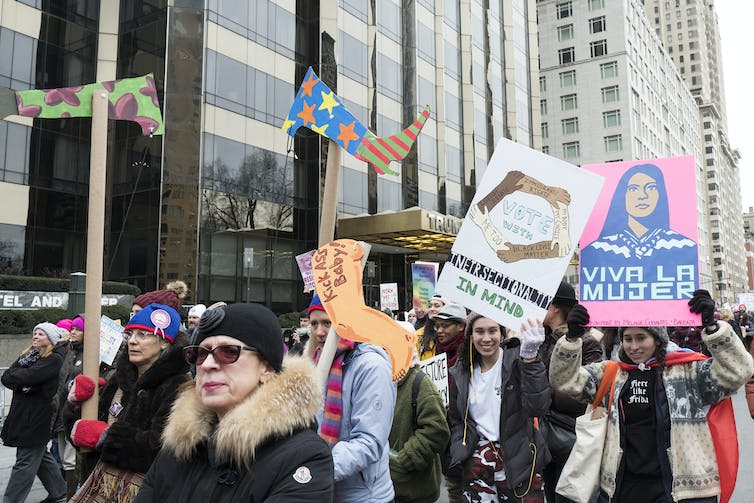In modern conversations on race and politics, a popular buzzword has emerged to describe the impact of belonging to multiple social categories.
Known as intersectionality, the social theory has a complex history and refers to the intertwining of different identities, such as class, gender and age. It is often applied as a way to understand how individuals may experience multiple forms of prejudice simultaneously.
The theory assumes that meanings associated with one identity are insufficient to explain the experiences associated with multiple, coexisting identities.
The origins of intersectionality
The term has its roots in feminist, racial and legal academic literature.
In 1977, the Combahee River Collective, a group of Black feminists, issued the Combahee River Collective Statement. The statement introduced the idea that one’s race, sex, sexual orientation and class were subject to different forms of oppression but ought to be examined simultaneously.
The term was formally coined a dozen years later by Columbia Law Professor Kimberlé Crenshaw, one of the scholars behind critical race theory.
That theory comprises a set of concepts that frame racism as structural, rather than simply expressed through personal discrimination. Scholars such as Crenshaw point to racial discrepancies in educational achievement, economic and employment opportunities and in the criminal justice system as evidence of how racism is embedded in U.S. institutions.
In her 1989 paper “Demarginalizing the Intersection of Race and Sex,” Crenshaw drew upon several legal cases to describe how Black women experience discrimination “greater than the sum of racism and sexism.”
In a speech two years later at the the Center for American Women and Politics Forum for Women State Legislators, Crenshaw further explained that in order to address “sexual harassment of African American women,” policymakers needed to understand the “intersections of race and gender.”
Today, Crenshaw hosts a podcast titled “Intersectionality Matters!” where she discusses the relevance of intersectionality in the #MeToo movement, the COVID-19 pandemic and other modern topics. She has also expressed concern over ways that the term has been distorted amid its politicization.
Why it matters
Intersectionality explores how people experience life through multiple coexisting identities.
Outside of intersectionality’s academic origins, there are many debates today over whether it is important for understanding workplace and policy issues.
Organizations are increasingly promoting intersectionality as part of their human resource strategies. For instance, Procter & Gamble Co., a large organization with common household brands such as Tide and Pampers, is one of them. “We’re creating an inclusive, gender-equal environment within P&G, while advocating for gender and intersectional equality in workplaces everywhere,” the company says on its website.
Two large consulting firms, McKinsey & Company and Deloitte, have also urged corporate clients to gather and analyze data related to their employees’ intersectionality. They argue that further understanding of intersectionality allows for more tailored firm strategies and equitable workplaces.
Ira L. Black/Corbis via Getty Images
Applying this guidance, Google created Self-ID “to build a workforce that’s representative of our users.” Self-ID allows Google employees the option to share identities beyond their race, ethnicity and binary gender with Google management.
In its 2022 Annual Diversity Report, Google described how Self-ID further “helps to make everyone at Google more visible” and encourages a more inclusive workplace.
Yet, these efforts do not come without controversy.
Shortly after the 2020 George Floyd murder, the FBI offered an employee training session on intersectionality. Training materials were obtained by Christopher Rufo, a senior fellow at the Manhattan Institute, a conservative think tank, through a Freedom of Information Act request. The training encouraged employees to reflect on their intersectionality and the role of intersectionality at work.
Conservative critics question the role of such training in creating equitable workplaces and argue instead that it encourages claims of racial discrimination and oppression in America.
The politics of intersectionality
Some elected officials have voiced support for policies that account for individuals’ intersectionality. In early 2022, for instance, U.S. Rep. Ayanna Pressley, a Democrat from Massachusetts, explained during a talk at Suffolk University, “We live in intersectionality … and our policies have to reflect that.”
To that end, Pressley introduced in 2023 the Abortion Justice Act to provide abortion access to all individuals “regardless of zip code, immigration status, income, or background.” She described the act as “inclusive and intersectional.”
Yet, other politicians have limited public discussions on intersectionality, especially within schools.
In May 2023, Florida Gov. Ron DeSantis signed into law Florida Senate Bill 266 in his ongoing effort to eliminate state funding for diversity training programs in public schools and universities.
Although the term intersectionality was ultimately removed during revisions of the bill, the new law prohibits teachers from using theories that suggest “systemic racism, sexism, oppression, and privilege are inherent … and were created to maintain social, political, and economic inequalities.”
For Crenshaw, the problem with such anti-woke laws is deeper than a question of censorship, but instead an attack on those “who value a multiracial democracy.”
“The whole point of anti-wokeness is to fundamentally change the story of the continuing relevance of enslavement and segregation,” Crenshaw said on Boston Public Radio in July 2023. “It chills teachers not to teach this material.”



